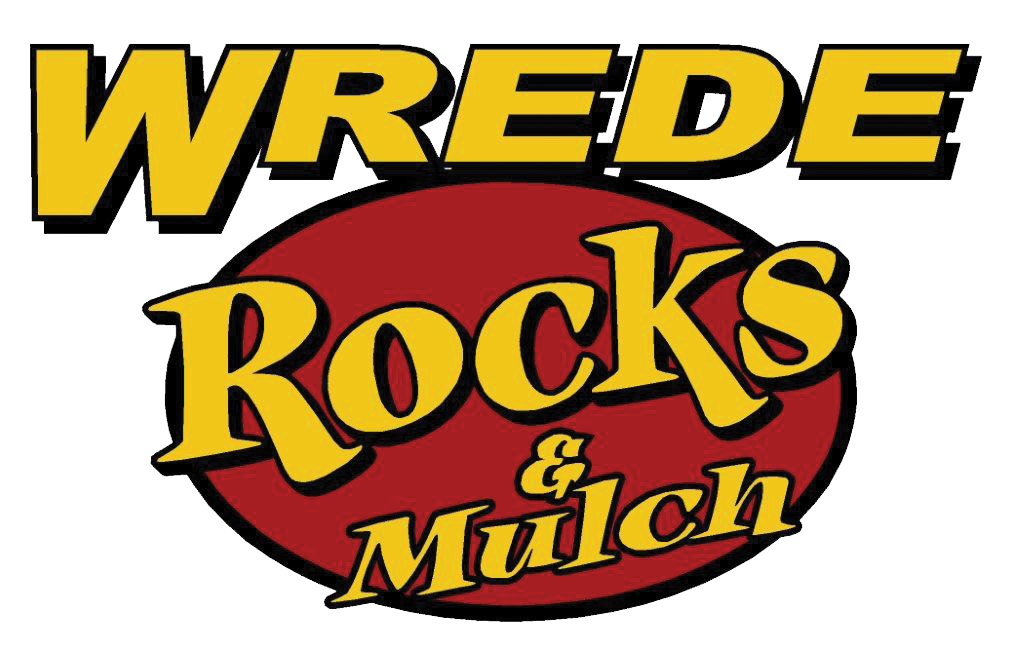FREQUENTLY ASKED QUESTIONS
+ Do you offer installation?
Only for mulch. Check out our selection!
+ What are the differentiating factors in mulch?
At Wrede Rocks, we pride ourselves on providing not only a quality product, but expert information for our customers so they can get exactly what they need when purchasing mulch. Indiana’s biggest mulch products are hardwood mulches and dyed or colorized mulches.
Initially, bark from Indiana hardwood trees provided raw material. These trees were debarked, and that bark was shipped to manufacturers like Wrede Rocks. Here, we would age and regrind the bark to achieve the colors and textures our customers love.
More recently, demand for bark has increased as supplies have decreased, so manufacturers are also selling hardwood mulch that is made from the whole tree. When aged and ground in the proper manner, this product looks and acts similar to hardwood-bark mulch. However, while all mulches fade with time, whole-tree hardwood mulch does not hold its color as long as hardwood-bark mulch. At Wrede Rocks, we clearly distinguish these two types of hardwood mulches, reflected in different prices. We also make Nutra Mulch, a hardwood mulch enhanced with horse manure to enhance its nutritional value.
Change has also occurred in how dyed mulches are manufactured. The industry began with the grinding and dying of old pallets and construction debris. But as the availability of this discarded wood remained constant and demand increased, there became a shortage of raw material. Like hardwood mulch, manufacturers began grinding whole trees. Fortunately, at Wrede Rocks, we have partnered with sawmills and pallet companies that use only virgin hardwoods and pallets for an exceptional dyed product.
+ Can I buy mulch that repels insects?
Cedar mulch contains natural, insect-repelling oil, but it is not guaranteed to deter all insects. This oil creates cedar’s trademark aroma, which repels insects. After being on the ground for some time, cedar mulch loses some of its strength at deterring bugs.
+ Do weeds still come up through mulch?
Yes, although it will slow them down. Putting Preen on your mulch in the spring will prevent weeds from germinating. However, Preen will not affect any weeds that have already sprouted and grown.
+ How do I know if I received all of the mulch I ordered?
Do your best to square off the pile you received. Measure the length, width and height in feet, and then multiply those numbers together. Divide by 27, and you will know how many cubic yards you have in your pile.
+ What causes the mold on the top of mulch?
The heat and humidity of summer can cause a fungus to grow over the top of your mulch. Your mulch naturally retains moisture to help your plants develop. Fungus thrives in dark, moist environments, and while it’s unsightly, it’s not harmful. This fungus can be easily removed by using a shovel to scoop it off and spraying a four-part bleach mixture on the affected area.
+ Does Wrede Rocks treat its mulch?
No. Chemicals are not used in the treatment of any mulch sold at Wrede Rocks.
+ What is the smallest quantity I can buy?
We will sell any product, in any quantity. From a baggie to a semi. Your wish is our command.
+ Should I add new mulch every year?
That depends on the type of mulch you use. In dyed mulches, color should remain vibrant for up to 2 years. For hardwood mulches, reapplication is recommended every year.
+ What's the reccomended depth for mulch?
Wrede Rocks recommends at least 4 inches of depth for your initial application of mulch and at least 2 inches each year after that. If you’ve used cypress, economy or dyed mulch, which has a higher wood content, you may need to remove old wood debris before applying any new mulch.
+ How many yards of mulch can I fit in my truck?
The exact answer depends on the length of your truck bed and the type of product you’ve purchased. Generally speaking, a 6' truck bed can hold about 2 yards of mulch, 1/2 yard of topsoil, or 1/2 ton of gravel.
+ What amount of mulch will I need?
One cubic yard of mulch covers about 100 square feet at a depth of 3 inches. To determine how much mulch you will need, you must measure every area you want to cover. Measure the length and width in feet, then multiply those measurements together to determine the square footage. Then, divide that number by 100 to learn how many cubic yards you will need. For your convenience, you can use our product calculator to help you with these calculations.
+ Are termites drawn to hardwood bulk mulch?
Not in Indiana. Our state’s termites are subterranean, drawn only to wood below the surface of the earth. Wrede Rocks further assures termite-free mulch by getting its supply mainly from Indiana sawmills, which extract the bark but not the wood. Additionally, our bulk mulch reaches temperatures of more than 150 degrees in the composting stage — bad news for any bugs that happen to be in the mulch at that time.
